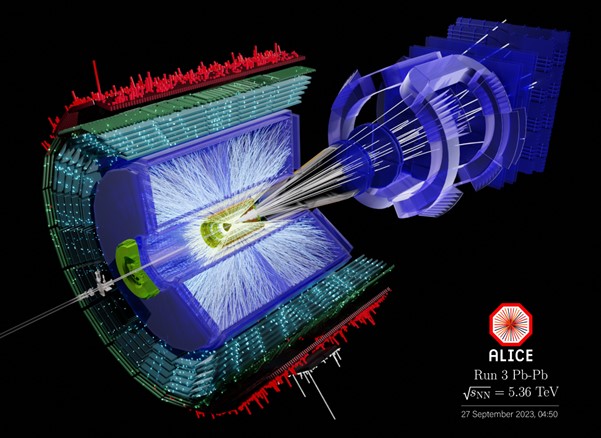Heavy ions are back at the LHC!

After five years of anticipation, and a major upgrade of both accelerators and experiments, the first long heavy-ion data taking period of the Large Hadron Collider ‘Run 3’ has started on Tuesday 26th September. Thanks to the excellent and intense preparation by many colleagues around the world, the ALICE experiment was able to immediately start recording collisions.
https://home.cern/news/news/experiments/lhc-lead-ion-collision-run-starts
The LHC will be steadily ramping up the beam intensity aiming to reach 50 kHz interaction rate at the ALICE interaction point. However the experiment has already successfully collected data from several hundreds of millions of hadronic lead-lead collisions, which our Liverpool ALICE group, including Jaime Norman and PhD student Danny Jones, is eagerly looking forward to analyse!
The ALICE Data Preparation Group, involving our Liverpool teammate Jian Liu as one of the data processing quality assurance coordinators, immediately started the first asynchronous reconstruction of the data, as seen on the beautiful display of an event from the first runs shown below.

Marielle Chartier, who leads the ALICE group in Liverpool and chairs the ALICE Collaboration Board at CERN, said: ‘This is a very important milestone not only for the whole international ALICE Collaboration but also for our ALICE team in Liverpool, which in fact marks the 10-year anniversary of the Physics department joining the ALICE Collaboration.’ She added, ‘Congratulations for this major achievement are due to all the Liverpool colleagues, past and present, students, technicians, engineers, physicists, who were involved, throughout these last 10 years, in the design, building (in the LSDC and at Daresbury Laboratory) and commissioning of the Inner Tracking System upgrade in particular.’

During the Runs 3 and 4 of the LHC, which will be taking place over the next decade, ALICE will be able to collect much more data from the LHC proton-proton, proton-ion and heavy-ion collisions much more quickly than hitherto. With its new and improved capabilities, ALICE will focus on high precision measurements of short-distance dynamics in QCD (quantum chromodynamics) at high temperature. ALICE also hopes to gain a deeper understanding of the quark-gluon plasma. In particular, new measurements are foreseen, down to very low transverse momentum, of rare probes such as heavy-flavour particles, quarkonium states, real and virtual photons, as well as measurements of jet quenching and exotic heavy nuclear states.
For further reading about the upgrade of the ALICE experiment and its research programme:
The Innovation News Network (Issue 10) 2022 https://www.innovationnewsnetwork.com/inside-the-upgraded-alice-nuclear-physics-experiment-at-cern/20346/?fbclid=IwAR01qDAT9JcsIQH5FYHVSJQ4In9yiTn-0Luawf6JUa10iZ-U2ritFceCAOE